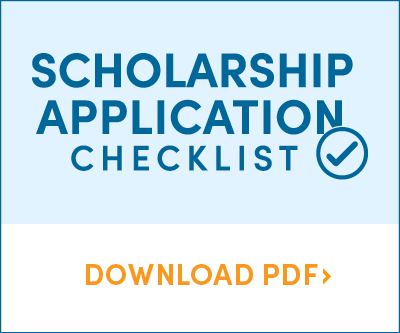Applying for scholarships takes time but shouldn't dominate your busy student schedule. The thought of adding another item to your growing list of things to do is one of the biggest reasons students decide not to apply for scholarships. There's no one secret to making the scholarship application process happen--it takes work and dedication. Still, you can do a few things to make it easier. Use the below seven-step checklist to streamline your application process.
- Research Your Scholarship Options Many scholarship opportunities exist for all ages, from elementary to graduate school. These scholarships can be funded by small-town businesses, large corporations, national, state, regional, and county affiliations, and even community clubs and niche organizations. High school counselors are an excellent scholarship resource for high school students. Most colleges have a scholarship site that lists financial support options related to the school.
- Gather Your Personal Information You'll likely need to use the same personal information applications. This includes: • Contact Information: address, phone number, email address, etc. • High School or College Transcripts: official or unofficial • Standardized Test Scores: ASVAB, ACT, SAT • Letters of recommendation: Check to see if the scholarship provider wants the recommender to submit or sign your letter personally. • Proof of Citizenship: Birth certificates, passports, state ID, tribal nation ID, voter registration, etc. • Essays, Videos, Personal Statements, etc. • Financial Information: These requirements are usually for need-based awards and may include your FAFSA Submission Summary and/or parental household income and/or assets. Never provide bank account or credit card information, as these are likely scholarship scams! Creating a folder with the above-standard information is a good idea, as you'll submit multiple scholarship applications. Consider making a master Scholarship Application folder with subfolders for your transcripts, letters of recommendation, essays, and other essentials. This will save you time, help you remember to include essentials, and boost your chances of winning the scholarship!
- Prepare Your Academic Records Merit scholarships almost always require transcripts as a record of academic performance, course load, and diploma status. The scholarship committee uses transcripts to prove GPA, course rigor, student involvement, and educational awards. Review the scholarship application requirements to determine if you need an official or unofficial transcript. High school students usually get their transcripts from the school counselor or office. In contrast, college students should contact the registrar office for their transcripts.
- Request Your Letters of Recommendations Your recommendation letters are important as they highlight your best qualities and top off any application. These usually notable people vouch for your abilities and dote on your strengths.
- Write Your Personal Statement or Scholarship Essay Save your essays, as you can use parts to create or modify new ones. This includes your personal statement. This is where it's wise to create a folder labeled, "Essays" so you can have access to all versions. It is okay to reuse essays but be sure you have clearly addressed the essay prompt and direction. Avoiding the essay prompt is one of the quickest ways to have your scholarship application thrown out. You'll need to proofread your essay a few times and on different days to avoid errors. Next, ask your peers or instructors if they'll proofread your essay two more times. Having at least two independent reviewers besides yourself is a good idea. Ensure you provide them with an essay prompt to see if they feel your essay clearly addressed the prompt and followed instructions. Pay attention to the minimum and maximum word count requirements. Scholarship judges are looking to see if you can follow simple instructions!
- Prepare Your Financial Information Every student should complete the Free Application for Federal Student Aid (FAFSA), and completing this form will require specific financial information. Depending on the timeline, some scholarship providers may require applicants to have submitted their FAFSA as a scholarship requirement. Other scholarship applications may ask for tax returns, income statements, or assets to prove financial need. It's a good idea to begin gathering these key financial pieces!
- Gather Additional Supporting Documents It cannot be stressed enough to begin saving your best work as it may be the perfect supplement to your scholarship application or a requirement. Students applying for an art or design scholarship may need to share their digital portfolio or specific pieces. STEM scholarship applications may request you share special projects. Any extra details about yourself that help you stand out should be part of the scholarship application asset you have available. This may include volunteer work, work experience, leadership roles, and more. Again, this is a reason to begin developing and continuing to add to your student portfolio now.
- Review and Submit Your Scholarship Application When you think you're ready to submit your scholarship application, step back and check to be sure you've attached or included every requirement. Double-checking and reviewing all parts of the application before submitting it will prevent your scholarship from being immediately discarded. Ask yourself questions like: Did you use the correct address? Was your personal statement included? Did the video requirement require a social post and a specific hashtag usage? How many letters of recommendation were required? Is this scholarship application to be submitted online or via a paper application?


